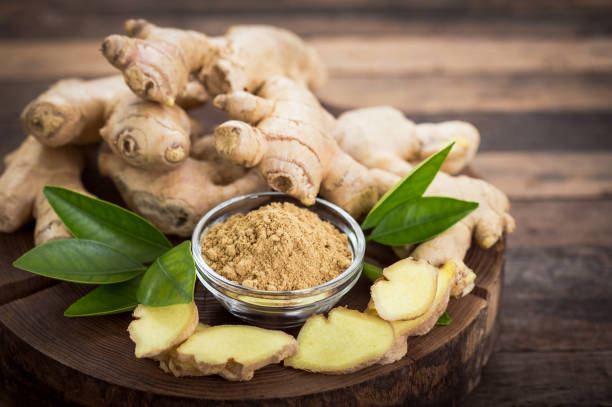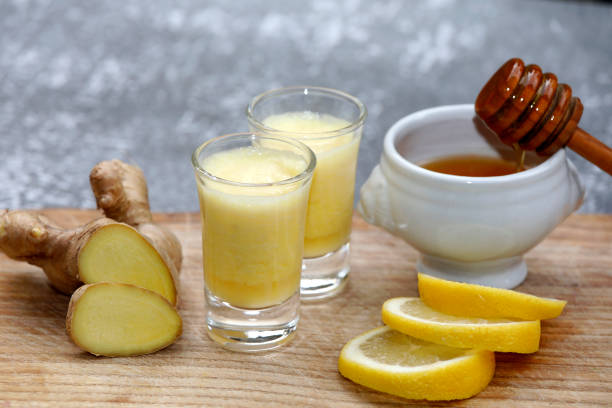In the lush garden of nature’s offerings, there stands a root that commands attention—an aromatic, flavorful spice known as ginger. But beneath its zesty exterior lies a treasure chest of health benefits that has been valued for centuries in traditional medicine. Today, we embark on a journey into the captivating world of ginger root, an age-old remedy renowned for its ability to soothe nausea, combat inflammation, and more. Yet, ginger is not just a healer; it’s also a culinary virtuoso, lending its vibrant flavor to both sweet and savory dishes. “Ginger Root: Nature’s Spice for Wellness” is your gateway to unlocking the wellness secrets and culinary magic hidden within this remarkable root.
The Spice That Sets Hearts Aflame
Close your eyes and imagine a root, gnarled and unassuming, yet exuding an unmistakable fragrance—the ginger root (Zingiber officinale). For generations, it has been more than just a spice; it’s a timeless remedy and a culinary masterpiece.
Healing Traditions
Ginger’s claim to fame? Its potent healing properties. It’s a trusted ally in traditional medicine, offering relief from:
- Nausea: Whether it’s motion sickness, morning sickness, or just an upset stomach, ginger has a soothing touch.
- Inflammation: Its anti-inflammatory prowess makes it a natural choice for those seeking relief from joint pain and inflammation.
- Digestive Harmony: Ginger aids digestion, helping to calm an unruly stomach and reduce bloating.
Culinary Versatility
But ginger isn’t confined to the realm of wellness; it’s also a star in the kitchen. Its zesty kick adds depth and character to dishes both sweet and savory.
Ginger-Infused Honey Lemonade
Ingredients:
- 2 tablespoons freshly grated ginger
- 1/4 cup honey
- 1/2 cup freshly squeezed lemon juice
- 4 cups cold water
- Lemon slices and fresh mint for garnish
Instructions:
- Begin your culinary adventure by combining freshly grated ginger and honey in a small bowl. Let them mingle and infuse for about 10 minutes.
- In a pitcher, mix the ginger-infused honey with freshly squeezed lemon juice and cold water.
- Stir until the flavors harmonize.
- Pour over ice and garnish with lemon slices and fresh mint.
- Sip, savor, and let the zing of ginger dance on your taste buds.
Fun Facts: Ginger’s Mystique
- Ginger has been used in various cultures as a remedy for seasickness, leading to its nickname “sea spice.”
- In addition to its culinary and medicinal uses, ginger has found a place in aromatherapy, often used for its soothing scent.
- Ancient Greeks wrapped ginger in bread and ate it after meals as a digestive aid—a tradition that continues today in various forms.
Exploring the Science Behind Ginger’s Powers
To truly appreciate ginger’s extraordinary abilities, we must delve into the science that underpins its healing potential.
Gingerol: The Secret Ingredient
At the heart of ginger’s magic lies a bioactive compound called gingerol. It’s responsible for much of ginger’s therapeutic properties, including its anti-inflammatory and antioxidant effects.

Nausea, Be Gone!
One of ginger’s most celebrated virtues is its power to quell nausea. Whether it’s due to motion sickness, morning sickness during pregnancy, or the aftermath of a hearty meal, ginger has been a trusted remedy for centuries.
Fighting Inflammation Naturally
Inflammation is at the root of many chronic diseases, and ginger is nature’s answer to combat it. By reducing inflammatory markers in the body, ginger offers a natural and holistic approach to wellness.
Digestive Harmony: Ginger’s Gift
In a world where digestive discomfort is all too common, ginger steps in as a gentle yet effective solution. It aids digestion by stimulating the production of digestive enzymes, facilitating the smooth passage of food through your system.
Culinary Versatility: Ginger in the Kitchen
Beyond its medicinal qualities, ginger adds a burst of flavor and complexity to culinary creations.
Spicy Ginger Stir-Fry
Ingredients:
- 2 tablespoons vegetable oil
- 2 cloves garlic, minced
- 1 tablespoon freshly grated ginger
- 1 red bell pepper, thinly sliced
- 1 yellow bell pepper, thinly sliced
- 1 cup snap peas
- 1 carrot, julienned
- 1 pound boneless chicken breasts or tofu, cut into bite-sized pieces
- 2 tablespoons soy sauce
- 1 tablespoon honey
- Sesame seeds and chopped green onions for garnish
Instructions:
- In a wok or large skillet, heat the vegetable oil over medium-high heat.
- Add minced garlic and grated ginger, stirring until fragrant, about 30 seconds.
- Add the chicken or tofu, cooking until browned and cooked through, about 5-7 minutes.
- Toss in the bell peppers, snap peas, and julienned carrots, stir-frying for another 3-4 minutes until the vegetables are crisp-tender.
- In a small bowl, whisk together soy sauce and honey, then drizzle this delectable concoction over your stir-fry.
- Stir-fry for an additional 2-3 minutes, letting the flavors meld together.
- Serve over steamed rice and garnish with sesame seeds and chopped green onions.
- Enjoy the burst of ginger’s zesty warmth!

Ginger in History and Culture
To truly understand ginger, we must take a journey through history and across cultures. This versatile root has played a significant role in diverse traditions around the world.
Ancient Roots
Ginger’s use dates back over 5,000 years to ancient China and India. It was treasured not only for its culinary appeal but also for its medicinal properties.
A Spice Fit for Kings
During the Roman Empire, ginger was considered an exotic and luxurious spice. It was highly sought after and often traded at prices equal to gold.
The Age of Exploration
In the Middle Ages, ginger became a staple in European cuisine and was used to preserve meats and flavor sweets. It was also one of the spices that drove the Age of Exploration, with European powers seeking direct trade routes to the source of this prized spice.
Culinary Magic: Ginger Across the Globe
Ginger has a remarkable ability to adapt to different cuisines, adding its signature warmth and zing to a wide range of dishes.
Ginger Around the World
- India: Ginger is a cornerstone of Indian cuisine, lending its bold flavor to curries, chai tea, and various sweets.
- Japan: Pickled ginger, or gari, is a staple accompaniment to sushi and sashimi, cleansing the palate between bites.
- Jamaica: In Jamaican cuisine, ginger is used to make fiery ginger beer and to flavor jerk dishes, infusing them with a spicy kick.
- China: Ginger is used in various forms in Chinese cuisine, from fresh ginger in stir-fries to pickled ginger as a condiment.
Culinary Creativity: Ginger in the Kitchen
Innovative chefs and home cooks alike are continually finding new ways to incorporate ginger into their dishes.
Ginger and Turmeric Golden Milk
Ingredients:
- 1 cup of unsweetened almond milk (or milk of your choice)
- 1/2 teaspoon ground ginger
- 1/2 teaspoon ground turmeric
- 1/4 teaspoon ground cinnamon
- A pinch of black pepper
- 1 teaspoon honey or maple syrup (optional)
Instructions:
- In a small saucepan, warm the almond milk over medium heat.
- Stir in the ground ginger, ground turmeric, ground cinnamon, and a pinch of black pepper.
- Whisk the mixture continuously until it’s hot but not boiling, about 3-5 minutes.
- If desired, add honey or maple syrup to sweeten.
- Pour into a mug and savor the soothing and aromatic golden milk.
Ginger: A Culinary Companion
In your culinary explorations, don’t shy away from incorporating ginger into both sweet and savory dishes. Its versatility knows no bounds.
Sweet Symphony
- Ginger-Infused Desserts: From ginger-infused ice cream to ginger-spiced cake, this root adds an intriguing layer of flavor to sweet treats.
- Gingerbread Cookies: Spices like ginger, cinnamon, and nutmeg come together to create beloved gingerbread cookies, perfect for holiday celebrations.
- Ginger and Fruit: Ginger pairs beautifully with fruits like pears, peaches, and apples, enhancing their natural sweetness.

Gingerbread Cookies Recipe:
Ingredients:
- 3 cups all-purpose flour
- 2 teaspoons ground ginger
- 1 teaspoon ground cinnamon
- 1/4 teaspoon ground cloves
- 1/4 teaspoon salt
- 3/4 cup unsalted butter, softened
- 3/4 cup brown sugar, packed
- 1 large egg
- 1/2 cup molasses
- 1 teaspoon pure vanilla extract
- Royal icing for decorating (optional)
Instructions:
- In a medium bowl, whisk together the flour, ground ginger, ground cinnamon, ground cloves, and salt. Set it aside.
- In a large mixing bowl, cream the softened butter and brown sugar until light and fluffy.
- Beat in the egg, molasses, and vanilla extract until well combined.
- Gradually add the dry ingredients to the wet ingredients, mixing until the dough comes together. Divide the dough into two equal portions, flatten them into disks, wrap in plastic wrap, and chill for at least 2 hours.
- Preheat your oven to 350°F (180°C) and line baking sheets with parchment paper.
- On a lightly floured surface, roll out one portion of the dough to about 1/4 inch thickness. Use cookie cutters to cut out your desired shapes and place them on the prepared baking sheets.
- Bake for 8-10 minutes, or until the edges are slightly golden. Let the cookies cool on the baking sheets for a few minutes before transferring them to wire racks to cool completely.
- Once the cookies are completely cooled, you can decorate them with royal icing if desired.
- Enjoy the warm, spicy aroma and delicious taste of homemade gingerbread cookies!
Savory Splendor
- Ginger in Stir-Fries: A staple in Asian cuisine, ginger elevates stir-fries with its distinctive zing.
- Ginger-Spiced Soups: Ginger adds depth and warmth to soups, making them a comforting choice, especially during colder months.
- Ginger and Seafood: Seafood lovers can rejoice as ginger complements the flavors of fish and shrimp wonderfully.
Ginger’s Global Influence
Ginger’s appeal stretches far and wide, transcending borders and culinary traditions.
Ginger Around the World
- Caribbean Jerk Seasoning: The bold flavors of jerk seasoning, which include ginger, offer a fiery and tantalizing experience.
- Ginger Tea in Japan: In Japan, ginger tea (shoga-yu) is a popular beverage, often enjoyed on cold days to warm the body.
- Chinese Hot and Sour Soup: This beloved soup features the harmonious pairing of ginger and black vinegar, creating a delightful balance of flavors.
- Ginger in Thai Cuisine: Thai dishes often feature ginger, adding a refreshing twist to curries and soups.
As we bid farewell to our exploration of ginger root, we find ourselves standing at the intersection of ancient wisdom and modern discovery, where the aroma of spice and the promise of wellness meet. Ginger, with its rich history in both culinary and medicinal traditions, has proven itself as a remarkable gift from nature.
We’ve traversed its illustrious past, from its humble beginnings in ancient China and India to its transformation into a symbol of luxury during the Roman Empire. Ginger’s journey across the seas during the Age of Exploration marked a pivotal moment in history, further emphasizing its value.
In the realm of modern wellness, ginger continues to shine. Its anti-inflammatory properties offer a natural way to combat chronic diseases, while its digestive support and nausea-relief capabilities bring comfort to our fast-paced lives. As an antioxidant, ginger stands as a guardian of our cells, safeguarding our health and well-being.
Yet, ginger is not merely a remedy; it’s a culinary companion that enriches our meals with its zesty warmth. From soothing ginger and turmeric golden milk to the fiery delights of a spicy ginger stir-fry, it adds depth and flavor to dishes from around the world.
In ginger, we discover a timeless bridge that connects cultures, flavors, and well-being. It’s a spice that unites us in the kitchen and in the quest for a healthier, more vibrant life.


